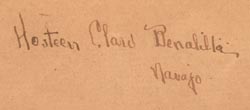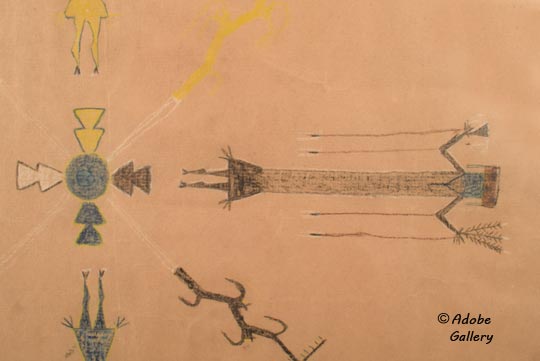Hosteen Klah Sandpainting Drawing by Franc Johnson Newcomb [SOLD]
+ Add to my watchlist Forward to Friend
- Category: Drawings
- Origin: Western Artists
- Medium: color pencil on paper
- Size:
17-½” x 17-½” image;
19-½” x 19-½” framed - Item # C4872 SOLD
 This drawing of a Navajo sandpainting is typical of the work of Franc Johnson Newcomb. It is the reproduction of a Navajo ceremonial sandpainting, probably from the Wind-way or Lightning-way ceremony. The story of such drawings is intensely interesting. It is notated in lower right Hosteen Claw Benalilla Navajo.
This drawing of a Navajo sandpainting is typical of the work of Franc Johnson Newcomb. It is the reproduction of a Navajo ceremonial sandpainting, probably from the Wind-way or Lightning-way ceremony. The story of such drawings is intensely interesting. It is notated in lower right Hosteen Claw Benalilla Navajo.
"Navajo sings are held for various reasons—religious, medicinal, as well as social. During ceremonies, which last as long as seven days and nights, the chanter (medicine man) each morning produces a sandpainting, which is destroyed at sunset. Franc discovered that she could recall these sandpaintings and reproduce them in exact detail. At first, she was afraid to do so because it contradicted Navajo religious law. But when (Hosteen) Klah discovered her ability, he encouraged her, after due consideration, because he recognized the importance of preserving these rites and rituals for future generations of his people. With so many Navajo children gone from the Reservation to government boarding schools, the opportunity to apprentice and train chanters was diminishing. Franc Newcomb represented a means of recording ancient Navajo rituals which would otherwise be lost.
Franc Johnson was born with a photographic memory and irrepressible energy, both of which enabled her to perform an invaluable service in the preservation of ancient Navajo rites and customs.
"Arriving at Fort Defiance, Arizona, in 1912 to teach Navajo children for the U. S. Indian Service, she met Arthur Newcomb, a young trading post operator. They were married in 1914 and set off to live on the Navajo Reservation at the Blue Mesa Trading Post which Arthur had purchased. The post was located midway between Gallup and Shiprock, and is now known as Newcomb, New Mexico. It was in this remote location, where they lived for 21 years, that she was able to begin her unique work. . .
"During the early years at Blue Mesa, the Newcombs became close friends of Hosteen Klah, chief Navajo medicine man. It was Klah who invited Franc to witness a Navajo sing. She was the first white woman ever admitted to such a ceremony.
"Her method was to observe the ceremony during the day, committing every detail to memory. After sundown she reproduced the images on large pieces of cardboard, noting on the back their meaning and symbolism. With the help of Klah, who corrected her work, she eventually produced over 600 paintings, most of which still exist today. Source: UNM Digital Repository
With the documentation of such important works, it became advisable to create a depository to house them. Here enters another woman to carry on the tasks begun by Franc and Klah.
Mary Cabot Wheelwright (1878-1937), a Bostonian matron who had a lifelong interest in the study of religion, made her first visit to New Mexico in 1918 following the death of her parents. Providence played a hand in 1922 when Wheelwright attended the Gallup Inter-tribal Indian Ceremonial. It was there that she purchased a large textile depicting an aspect of the Navajo creation story which had been woven by Hosteen Klah.
Wheelwright was introduced to Klah in 1923 by the Newcombs. "To Klah, having witnessed decades of relentless efforts by the United States government to suppress indigenous culture and beliefs, the future of traditional Diné religious practice was potentially bleak, and Klah was receptive to the possibility of collaboration and sharing this knowledge with allies. Wheelwright and Klah became friends, and over the next twelve years created a substantial permanent record of Diné ceremonial knowledge through chants, weavings and paintings. In this project they were joined by Franc Newcomb as well as others such as Father Berard Haile who sometimes acted as a translator. The extent of Wheelwright's dedication meant by the late 1920s she had not decided whether to invest in a publication program or a museum. Although she started an architectural competition for a new museum, the reality is that she opted for both, promoting the publication of Navajo ceremonial knowledge until her death in 1958.
"After some changes of plan as to where the Museum was to be located, it was built on land gifted by Amelia E. White (1848-1912), with the exterior construction complete in late 1937, and the interior continuing into 1938. The Museum was designed along the principles of a Navajo hooghan conceived by architect and furniture designer William Penhallow Henderson (1877-1943), in conversation with Klah. . . Source: Wheelwright Museum of the American Indian website
The eight-sided hogan shape of the original design for the museum was designed to display eight very large weavings by Klah of Navajo ceremonials.The museum became the repository of all of Klah's medicines. It is believed that these textiles were removed from display following the theft of one of them. In 1977, the museum repatriated all the ceremonial items in its collection in keeping with federal regulations.
By the generosity and dedication of three women-Franc Johnson Newcomb (1887-1970), Mary Cabot Wheelwright (1878-1958), and Amelia E. White (1848-1912)—with the enthusiastic cooperation of Diné hataali Hosteen Klah (1867-1937)—a significant number of Navajo ceremonial ways have been documented and saved for members of Navajo culture and others interested in studying it.
Condition: there is some water damage to the edges of the paper and some loss of pigment on the drawing. There is paint loss on the original frame.
Provenance: this Hosteen Klah Sandpainting Drawing by Franc Johnson Newcomb is from the collection of a resident of Texas who inherited it from her great grandmother who was the original owner. Her great grandmother was the first county health nurse to the Navajo in the Bernalillo area and knew Klah personally.
References:
- University of New Mexico Digital Repository, University Libraries
- The Wheelwright Museum of the American Indian website
- Personal correspondence with the granddaughter of the original owner of this painting
- Personal correspondence with a Diné College graduate
TAGS: Franc Johnson Newcomb, Western Art, Diné of the Navajo Nation

- Category: Drawings
- Origin: Western Artists
- Medium: color pencil on paper
- Size:
17-½” x 17-½” image;
19-½” x 19-½” framed - Item # C4872 SOLD
Adobe Gallery Recommended Reading
Adobe Gallery Recommended Items
If you are interested in this item, we would also like to recommend these other related items:



